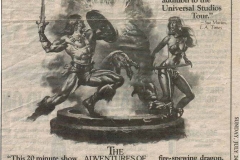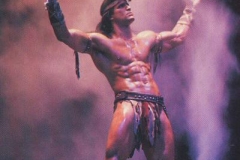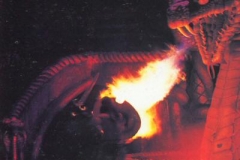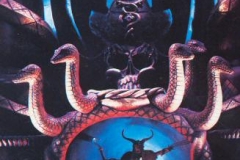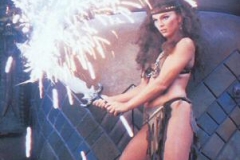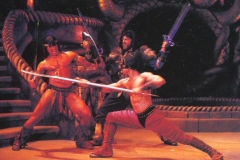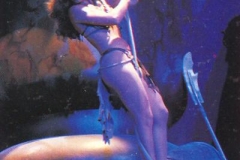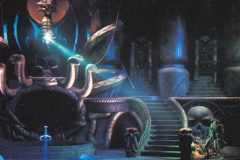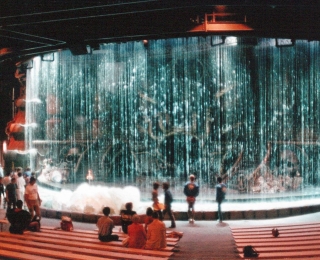Dates: June 18th 1983 – ?May 1994
Location: Castle Theatre
Enter the world of swords and sorcery, a magical time of wizards and warriors where fantasy and reality meld into an awe-inspiring spectacle of clanging steel and powerful spells. Conan has only his strength and sword to defend himself against evil forces more powerful than any man.
“The Adventures of Conan” is one of the most advanced synthesis of special effects, pyrotechnics, laser technology and live action ever combined into one thrilling presentation. Feel the heat as Conan battles the deadliest fire-breathing dragon ever.
From “Universal Studios Hollywood Guide”, 1991
An MCA Recreation Services production
Jay Stein, President
Barry Upson, VP Planning
Produced by: Peter Alexander
Project Manager: Larry Lester
Created by Landmark Entertainment (http://www.landmarkusa.com) and inspired by the 1982 film Conan the Barbarian.
Work began on the attraction in 1982 at Landmark, and the show opened to great acclaim on June 18th 1983 with a total budget of $5 million, in the Castle Theatre on the Upper Lot at Universal Studios Hollywood. The previous show in the venue was Castle Dracula, which closed in January 1983.
The show ran until early 1994, when it was replaced by Cinemystique: Illusions of the Night (starring the Pendragons) followed by Beetlejuice’s Rocking Graveyard Revue.
The Cinemystique show was performed on the same set (with minor redressing).
Many thanks to Peter Alexander for additional information
Photo Gallery
Teaser Advert
From Gary Goddard Facebook page:
The Water Curtain for Conan was amazing — we had smoke systems that would fill the stage during the load in. Dan Flannery created a light plan that would highlight the water while keeping the stage sets dark, and then when the show started, the Water Curtain would part, and Dan’s lighting seemed to cross dissolve to reveal the setting behind, while the water magically parted. It was a GREAT way to open a show. This shot looks like it’s one of the first nights where we got it working. I think we were probably setting light levels as well. Amazing memories – this show really put us – meaning me and my new young company (Gary Goddard Productions) — on the map, and it really was an amazing production. Key GGP staff member who were former WED Imagineers were part of it including Claudio Mazzoli, Joe DeMeis,and James Michaelson. Other GGP staff who worked on the show included Robert DeLapp, Terri Cardinali, Richard Hoag. and of course Tony Christopher. This show was Universal’s first big shot across the bow to Disney, showing them they (we) could pull of a major attraction on a par with anything DIsney was doing. In fact, we pushed beyond what they were doing. The show was “required viewing” at my former place of employment (WED Imagineering) — I was told that everyone in the design group had been instructed “to go over to Universal and see what Goddard did…..” And I personally brought over Al Bertino, Marc and Alice Davis, and Herb Ryman to see it. They were truly blown away. I told Universal that if they really wanted to boost attendance at the park, to just bring this back. I think A LOT of people would return to experience it once more.
The Cast
In 1983, the characters featured in the show were:
- Conan the Barbarian
[1984, Anthony B. Carroll] - Red Sonja
[1993, Karen Sheperd] - Wizard Kallias
- Taras Mordor (evil sorceror)
- Azura (axe-wielder)
- Double Swordsman
- Balash-Cushite<
- Young Conan
[1990, Mark Dacascos]
The above partial information on actors is incomplete – if you can help with corrections / additions please contact us.
 Music / Soundtrack
Music / Soundtrack
Basil Poledouris (1945 – 2006), who also scored the movie CONAN THE BARBARIAN was hired by Universal and Landmark to provide a score to run throughout the live-action show.
The recording used in the show was performed by the London Philharmonic.
The (now) rare full soundtrack CD (consisting of the music, and the full soundtrack of the live show) can be obtained on the Super Tracks label.
The Plot
(from Wikipedia)
The stage is decorated to resemble a ruined temple filled with treasure. A skinny young man and a young woman resembling Red Sonja descend onto the stage down a rope, with the intention of plundering the temple’s treasures, and are surprised to find a “good wizard” waiting in the temple. While the man talks to the wizard, the woman becomes hypnotized by a large red gem set in a statue and dislodges it, accidentally releasing a trapped evil wizard in the process. The evil wizard summons henchmen, who swordfight against the man and woman and good wizard. The good characters prevail, but the evil wizard raises the henchmen from the dead, stronger than before, and destroys the good wizard with a fireball. The situation looks bleak, until the young man accidentally picks up a magical sword that turns him into the musclebound Conan. With his new strength and magic sword, Conan dispatches the henchmen, and then throws the evil wizard into a pit in the middle of the stage. The evil wizard re-emerges from the pit as a giant, fire-breathing dragon, and Conan and the woman fight against it, finally defeating it and sending it back into the pit. Triumphant, the two fill their packs with riches and ascend their rope out of the temple.
Legacy
For many years after Conan, a part of the show remained clearly visible in the park. One of the swords from the show was displayed outside Terminator 2:3D. When Despicable Me moved in, the sword was removed.
Press Release 1983
Universal Studios Tour, an excursion behind-the-scenes through Hollywood’s biggest and busiest movie and television studio, is celebrating it’s 20th birthday this July. The Tour, which started modestly by giving tram tours daily to less than 200 people, is today California’s third-most popular attraction.
In 1983, more than 3.5 million guests are anticipated to visit the 420-acre entertainment complex, which produces more prime-time television series and movies and more feature films that any other studio in the world.
To help celebrate the Tour’s 20th year in operation, Universal creative and special effects experts are devising the Tour’s most complex and rousing attraction to date, “The Adventures of Conan”, a sword and sorcery spectacular.
Insprired by the popular 1982 Universal Pictures release Conan the Barbarian, the new Tour show will be a $3.75 million production featuring state of the art, never before seen laser and pyrotechnic special effects, combined with the skills and computer-coordinated animated characters.
The “Adventures of Conan” production team led by tour vice- president Peter Alexander and a staff of top Hollywood special effects and dramatic consultants, recently announced that the show will debut June 18. They are currently perfecting and safety testing the myriad of delicate special effects, including an 18-foot tall, fire-breathing dragon that shoots twin lasers from its eyes.
The dragon, controlled by a series of sensitive computers, appears during the climax of the show. According to Alexander, the special effects contained in the dragon – when combined with the show’s magical illusions, other lasers, live actors and animated characters – is a first in live theatre, anywhere.
“The Adventures of Conan” is located in the heart of the Tour’s Visitors Entertainment Center, site of three other live shows, two museums, exhibits, shops, food and refreshment stands and leisure-picnic areas.
Full Show Video
Excerpts
Behind the Scenes
THE ADVENTURES OF CONAN: BEHIND THE SCENES
3 minute behind the scenes documentary looking at the special effects used to make Conan so spectacular. From 1988 Kodak documentary “Beyond Behind the Scenes: Universal Studios Hollywood”
Technology
From “On Location”, August 1983 (http://www.totallyfuncompany.com/conanmedia/articles/Conan-5.JPG)
Universal’s ‘Adventures of Conan’ Bewitches Audiences With EFX & Live Action
By Beth Anderson
Setting: Hell.
A leaden incubus hands in the fetid fog of the underworld. With hearts pounding, the hero and his female companion glance apprehensively around.
Stillness.
Movement.
A rasping hiss, a deafening roar, the earth thunders as the leviathan head of a great serpent explodes from the deep. The startled victims whirl to face the sound as the titanic reptile spits bolts of fire at its prey. Spears of lightning slice through the fiery chamber as the hero and his companion battle the great serpent. Suddenly the viper screams and recedes into the earth.
Not since the days of Disney’s dinosaur dioramas has there been such a bewitching exhibition of audio-animatronics as seen in the new live theater sword and sorcery spectacular, the “Adventures of Conan”, currently showing at Universal Studios Tour. This live presentation, inspired by the 1982 adventure film “Conan the Barbarian”, features highly complex, cinema-quality, state-of-the-art special effects that break new ground in live entertainment.
The central motif focuses on the adventures encountered by the hero, “Conan the Barbarian,” and the heroine, “Red Sonja,” as they attempt to free themselves from imprisonment within the palace of evil sorcerer Taras Mordor. The special effects were archetypal in that live actors performed within an environment of lasers, pyrotechnics and animatronics, effects which require carefully monitored safeguards.
An intricate network of computers monitors the various technical elements of the show (live actors, lasers, pyrotechnics, animatronics, effects). The master computer is the INTEL computer, an analog computer which allows functions to happen via signals it sends to the remaining computers. They interface with the INTEL and do all their own logic and analog controls, which interface and allow the lasers and certain canned sound effects to happen. The subordinate computers include the Allen Bradley computer, the T1520 (lasers), the serpent computer and the lighting computer.
The Allen Bradley controls the actors’ interface with all the technical devices and allows the actors to move within specific areas safely. It controls all of the pyrotechnics and safety devices as well as doing the actual logic. Show project manager, Larry Lester, explained the application of the Allen Bradley.
“The Allen Bradley serves as the nucleus for all of the digital information that comprises the sensors for all the safety devices. It says, ‘if this is true, this is true and this is true, then we can do this.’ Essentially, it’s the safety device. It says, ‘the actor’s in place; he’s stepping on a safety mat; the SMPTE Time Code is in the correct position; a window is available in the SMPTE code; the laser is enabled; the actor is breaking an infrared beam,’ and then there’s a laser hit. When that laser is fired, you get another signal to the Allen Bradley, and that ‘allows a chip’ that has a specific repeatable sound in it to go through its sequence.
“With each specific laser effect, where there is the potential danger of the actor getting involved in an area where the laser might be, there are pressure sensitive mats in the floor that require an actor to have a foot on each mat. The minute he lifts a foot, the laser is disenabled. If he is not on that mat, then he’s someplace else on stage, and one of those places that he could be is in the way of the laser.
“Overriding all of this are the laser safety officer and the technical director whose hands are constantly on a button which is flashing, indicating to him by that flash that that specific window is now open. If there’s any danger that he sees on stage, if he were to lift his finger at any time, the laser will be disenabled. It involves a human making a judgement in addition to what the computer is doing.
“Essentially everything starts from the SMPTE code, which is the real time that’s set to the music track. There are variables within that which are time windows, during which an effect can happen, which helps us take advantage of little idiosyncrasies in the actual blocking. If they’re a few seconds late on a specific effect – some of the windows are only five seconds long; some are 15 to 20 seconds long – a specific laser cannot happen except within that 20-second window. It doesn’t fire the laser, it just says that the laser can only happen during this time window,” said Lester.
In conjunction with these time windows are the sound effects, which must also be co-ordinated with real time. Sound Chamber’s (North Hollywood) Jerry Laidman, who designed the sound system for the show, outlined his involvement with the effects, “We developed a digital bubble memory storage of audio effects enabling us to co-ordinate audio effects with real time activities. The laser will have a window of activity, and since the laser is going to fire sometime within that window, we’ve got to have the sound happen exactly when the laser happens. So we developed a method of storage of audio which can be instantaneously replayed through a digital bubble, therefore when the laser fires, we fire an audio effect that happens instantaneously.
“In the effect where Red Sonja moves her sword to block the laser beam, that takes place by her moving the sword through a photocell, which means yes, the sword is in the right position, which activates the laser, which then fires at the sword, and the sound effect fires simultaneously with the laser.
“The sound is handled in several different areas. The sound for the majority of the program is handled through a digital storage system. We chose digital because it doesn’t deteriorate over a long period of time. The there are the special timed effects which are stored on digital, but they’re on hard memory digital, not tape digital. By having them on hard memory, they can be easily accessed. I sent the effects through the different sound systems – the ‘four-point source system’ – meaning that when an actor is left stage, the sound comes from left stage. Or when he’s right stage, it comes from right stage. When the serpent comes up, the sound of the serpent comes from the serpent area rather than from the main house speakers,” said Laidman.
Properly orientated sound was not the only obstacle to overcome in the process of bringing the serpent to life. According to its designer, Tom Reidenbach of Animated Show Productions, Los Angeles, “It’s the largest piece of audio-animatronics with that many complicated programmed moves. Earlier in the ’50s, Disney did some big dinosaurs in a diorama, but they simply moved their heads and mouths a little bit. The serpent is absolutely and completely programmed into the show to work with live actors. It was out of a whole new realm of animation although the technology was really there already. We had it developed; we just had never done anything quite that large before, nothing that’s had to run constantly on a 12 to 14 hour-per-day schedule, 365 days a year.
“It’s one thing to build a special effect for one take and get through the shot, but it’s a whole other ball game when you start building a serpent that has to come on cue every single time. So it did present some problems that heretofore we had not experienced.
“My partner (Dave Schweninger) and I did all the animation and programming – we don’t just physically build these things – we also do the movement. We actually choreographed the movement within the show itself. We put that on our computer; then it, in turn, is transferred into the main show computer system once we have our system – our movements – choreographed to the score and to the actors. Until we get it looking good, we do one movement at a time. For example, we may do entire segments where we just do the head turn. We have ‘head nod,’ which is up and down; ‘head turn,’ which is side to side; then we put in ‘head tilt,’ which is like a rolling motion.
“We program each one of its movements individually. We run the program through and program the mouth, then lay in on top of that the head turn, then the head nod – you do that with each and every one of the movements throughout the serpent. To get it to rise up, we used an elevator system for which we built a platform. The platform is a series of chain drive gears which are actually driven by an electric motor in a big shaft that pulls the entire platform up, which we call the animation base. That physically is about 24 feet down under the stage. We’ve developed a system of pivoting his body so that it looks like he’s a lot deeper than he actually is when he comes out of that hole. We put it from a point where it appears to be that he’s about 20 to 30 feet below where he actually is.
“The skin is a vinyl with a foam backing – developing one with vinyl skin that can actually move within an animation base is something else altogether,” continued Reidenbach. “Of course, it had to be realistic. The main head components are fiberglass: then we have a variety of plastics that are used in some of the membranes. The horns themselves are foam with fiberglass over them. The eyes are – it’s an old neon trick – it’s really two neon coils in there. One is red; one is green, causing them to change colors when he shoots the lasers. The main frame itself is a combination of fiberglass structural members, steel and aluminium.” And what happens when the serpent breathes fire? “Actually,” clarified Reidenbach, “the flame doesn’t occur until well outside the mouth, so we have very little heat buildup in there during the show.”
The serpent posed problems of a different nature for laser specialist Dr. Sandor Holly of InterScience Technology. “The only feasible way to produce the effect of the laser beams seeming to emanate from the serpent’s eyes was to have the beams originate from under the floor,” explained Holly. “We send the beams up to the serpent’s eyes through windows in the floor. The problem, of course, is that the serpent cannot be positioned very accurately, and if you don’t accurately orient the serpent, the beams would run past the serpents head up into the ceiling.
Casting Call
From Orange Coast Magazine, May 1983
HELP WANTED: UNIVERSAL STUDIOS SEEKS BARBARIANS
Are you out of work? Spare a dime, brother? Can’t stand unemployment insurance lines?
We’ve got the job for you.
Universal Studios Tour has begun production on a new “Adventures of Conan” sword and socery [sic] spectacular show, featuring state-of-the-art laser, lighting, sound, computer and pyrotechnic special effects. The “Adventures of Conan,” scheduled to open June 18, will be the tour’s major new attraction for 1983.
The “Adventures of Conan,” with a production budget exceeding $3 million, will be the most costly and complex attraction built during the tour’s 18-year history. The show will incorporate a variety of computer-generated special effects, including seven different laser effects, two of which have never before been used in movies, television or live stage shows. The climax of the sword and sorcery spectacular is the appearance of an 18-foot tall, fire-breating dragon that shoots twin lasers from its eyes. The cavalcade of special effects will interface with professional actors in intricate live action, highlighted by stunt sword fights, sorcery demonstrations, duels, daring climbs and high falls.
The demands on cast and crew of the “Adventures of Conan” will be intense and the planning, blocking and ultimate execution of scenes involving the special effects – particularly the lasers – will be done in accordance with the strictest safety procedures, safeguarded by six computers. The cost of the computer safeguards alone will exceed $150,000.
“Adventures of Conan” production experts are planning a series of open casting calls in April to locate actors and actresses with precisely the right combination of performing skills, athletic ability, stunt experience and appearance. More information of the open casting calls will be announced.
The “Adventures of Conan” is being developed and produced by tour creative design and special effects experts led by producer Peter Alexander and project manager Larry Lester. A group of top consultants has been retained to work on the project, including:
writers and directors Gary Goddard and Tony Christopher of Gary Goddard Productions, Hollywood;
Gene Evans, Astro Pyrotechnics, creator of special effects for the MGM Grand Las Vegas “Jubilee!” show;
animation designers Bob Gurr and Dave Sweninger, formerly of Disney;
magic illusion designer John Gaughan, who has provided illusions for Doug Henning and Siegfried and Roy;
and lighting designer Daniel Flannery, a recent contributor to the new EPCOT Center and the “Evening with E.T. at the Hollywood Bowl” last summer.
The “Adventures of Conan” will replace “Castle Dracula”, which opened in June, 1980 and gave its final performance on January 31.


